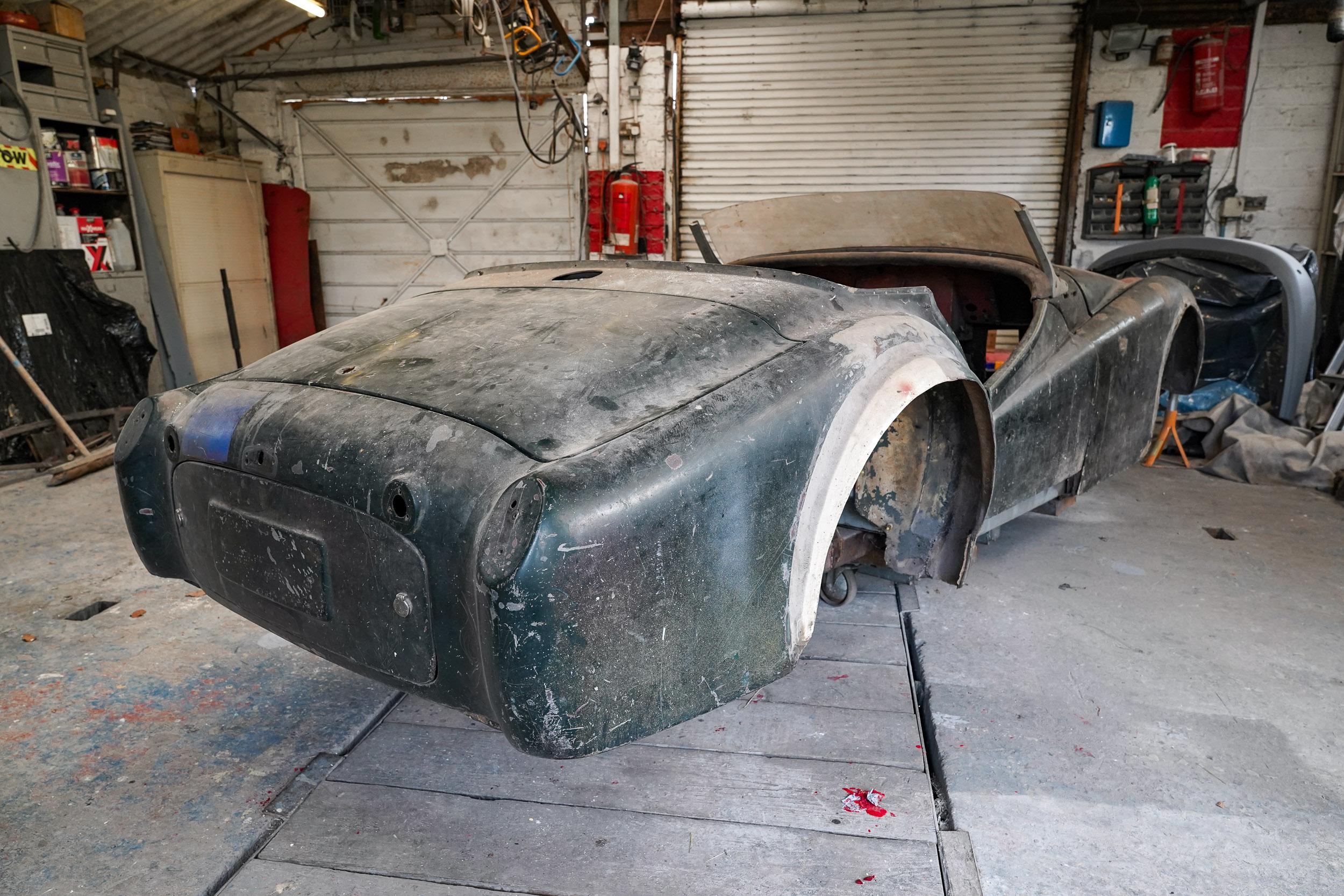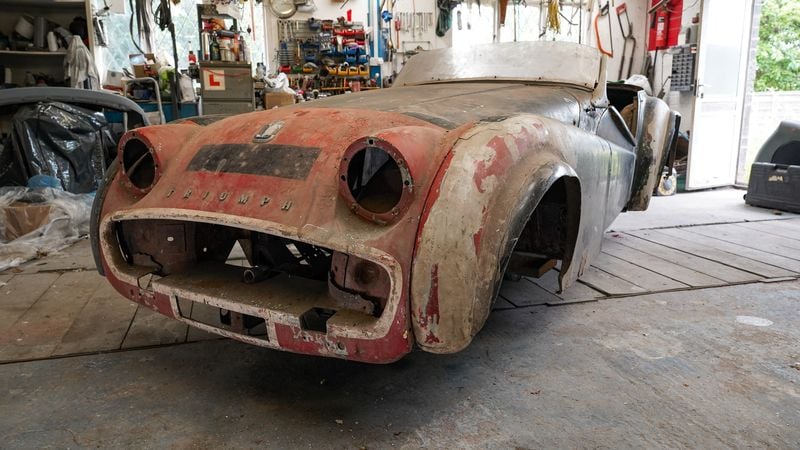1959 Triumph TR3S - Remains of Iconic Le Mans Racer #25
Highlights
- Restoration project, reported body shell of 1959 Triumph TR3S Le Mans race car #25
- No.25, sole survivor of three cars (No.25, No.26, & No.27) that were raced by Triumph in the 1959 Le Mans
- Partially restored body and chassis
- In current family ownership since 1961
The Appeal
However, with this body, the current owners are absolutely convinced this is the actual and real historic No.25 Le Mans TR3S, as purchased by their father, and restored together with him over many, many years.

The History and Paperwork
- Very large history file with historic receipts, magazine articles, private correspondence, and many photographs of the vehicle comes along with the sale
- Copy of Motor Sport magazine with original advertisement for the body shell as purchased
- Racing modifications present on the car in convincing order
This body shell and chassis as it sits, is the reported and suspected remains of the No.25 Triumph Sports 20 TR3S Le Mans race car, raced in 1959 at the 24 Hours of Le Mans. One of three cars racing for Triumph, numbers 25, 26, and 27, they sported lengthened chassis and fibreglass bodywork that was six inches longer than standard TR3, to accommodate the larger ‘Sabrina’ DOHC race engines. All three cars retired in the 1959 race, and many of their parts were carried over to the 1960 TRS cars that were built based on experience gained from these TR3S cars, which helps to explain why it was originally presented as a body shell only in 1961. With many Triumph followers believing No.27 was cut up by the factory, No.26 destroyed in a fire, many others believing all three cars were destroyed, and a plethora of tribute and replica cars seen in operation today, it is often difficult to ascertain the authenticity of these claims, especially considering the absence of any direct documentation.
It is not uncommon for ex-Works parts and cars to lack proper documentation for a variety of reasons, including the recycling of parts into updated cars, serial numbers being lost, documentation being destroyed by the passage of time itself, and even the odd parts finding their ways into the for-sale market through unofficial channels.

The Condition
- Bare body and chassis with no running gear
- No suspension or drive components
- Owner states that the body shows only mild surface corrosion
- We understand that significant recondition and fabrication of replacement panels has taken place
- Work undertaken to rectify later modifications and return the car to original Le Mans specification
As it currently sits, as a bare body and chassis with no running gear or other suspension or drive components present, it is the result of a father and sons’ multi-decade team effort to restore the shell back to original Le Mans TR3S specification, and in hopes to eventually fit it with the period correct ‘Sabrina’ twin cam engine.
The car is sold 'as-is', with all documentation mentioned above and more.
The owner states that it is a fair and authentic TR3S shell and is the remaining majority of original elements of the car. As such he says that it fully represents the spirit of the car itself.
The sale also carries with it the priceless historical value of reportedly being one of the few vehicles which have participated in one of the greatest and most respected and prestigious races, the 24 Hours of Le Mans, and one of even fewer remaining classic survivors of this category. historical racers such as this are exceedingly rare, and indeed only become rarer as time goes on and vehicles are destroyed or forgotten.

Summary
Notice to bidders
- Year 1959
- Make Triumph
- Model TR3S (Le Mans racing car - remains of)
- Colour British Racing Green
- Odometer
- Engine size
- Seller Type Private
- Town Birmingham
- Location West Midlands
- Country United Kingdom
- ma•••• £42,000 12/07/23
- ma•••• £36,000 03/07/23
- jo•••• £34,500 03/07/23
- th•••• £34,000 03/07/23
- jo•••• £33,500 03/07/23
- ma•••• £33,000 03/07/23
- th•••• £32,000 03/07/23
- ma•••• £31,000 03/07/23
- ma•••• £28,000 03/07/23
- th•••• £27,000 03/07/23
The Gallery

About Max Bids
The max bid process allows you to bid without any hassle.
Enter your maximum bid and we will then bid on your behalf to ensure you're the highest bidder - just enough to keep you in the lead and only up until your maximum.
Anti-sniping
Car & Classic prevent auction snipers from bidding in the last seconds to win an auction.
Auctions are extended by 3 minutes if anyone bids within the last 2 minutes to allow other bidders to react and counter-bid.
Auto-bidding increments
- If your maximum bid is equal to or below the reserve price, your maximum bid will be applied in full if you are the highest bidder.
- If you are the highest bidder and place a maximum bid above the reserve, we will automatically put in the reserve as your first bid.
-
- Once the reserve has been met, Car & Classic will make sure you are the highest bidder using only the bidding increments stated below.
- We will keep you in the lead up until your maximum bid OR the increment closest to your maximum bid, providing your maximum bid is enough to cover the increment value.
| Bid Amount | Increment |
|---|---|
| £0 to £9,999 | £100.00 |
| £10,000 to £49,999 | £250.00 |
| £50,000 to £99,999 | £500.00 |
| £100,000 + | £1,000.00 |
Automatically outbid immediately
When you place a max bid and are outbid immediately that means that another bidder has placed a max bid limit which is higher than yours.
You can bid again and we will use our automatic bid system to try and get you as the highest bidder.
Matching max bids
When there are two max bids of the same value, the one placed first remains the lead bidder.
Pre-authorisation
We may hold a pre-authorisation charge on your card until the end of the auction when the hold will be cancelled. If you win, we'll take a security deposit which counts towards the payment for the vehicle and isn't any extra cost to you.
What are pre-bids?
A pre-bid means you're able to place a bid before the official start of the auction.
You will be notified whether or not you are the highest bidder when the auction starts.
Problem with your bid
Bids are contractually binding. To help protect you, we have some rules in place if we think it's been mistyped. Please check and amend what you have entered.
































































































































































































































































































































































































































































































